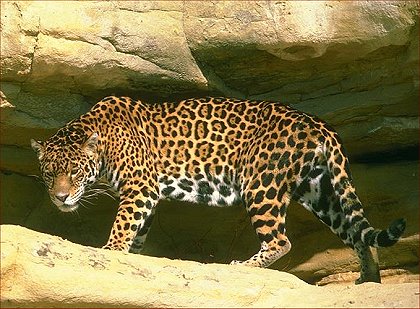Details on New Mexico Lawsuit over “Phantom Jaguar”
Most New Mexicans want to see critical species and habitats preserved if it can be done at a reasonable cost. But what about the imposition of a costly regulatory regime on behalf of a species that hasn’t been seen in the area for years? The following is a press release from the Pacific Legal Foundation, a free market-oriented public-interest law firm which filed suit against the US Fish and Wildlife Service on just such an issue last week.

Albuquerque, N.M.; May 21, 2015: Attorneys with Pacific Legal Foundation (PLF) today sued the U.S. Fish and Wildlife Service (FWS) for illegally designating tens of thousands of acres in New Mexico’s Hidalgo County as “critical habitat” for the jaguar even though the species has not been sighted in the county, or anywhere else in New Mexico, for years; indeed, the state doesn’t even have any environmental features that are essential to jaguar recovery.
Donor-supported PLF is a watchdog organization that litigates nationwide for limited government, property rights, and a balanced approach to environmental regulations. In asking the court to overturn the designation of jaguar critical habitat in New Mexico, PLF attorneys represent three broad-based organizations with members who are harmed by this reckless and unjustified expansion of federal Endangered Species Act (ESA) regulations in the region — the New Mexico Farm & Livestock Bureau, New Mexico Cattle Growers’ Association, and New Mexico Federal Lands Council.
PLF represents these organizations free of charge, as with all its clients.
Reckless regulating: Roping off “critical habitat” for a species that isn’t there
The jaguar’s global population is estimated to be at least 30,000; 90 percent live in tropical, jungle, and swamp habitats in Central and South America. According to the FWS Recovery Outline for the species, there are no jaguar populations in New Mexico — or anywhere in the United States.
The jaguar has been listed as “endangered” under the ESA since 1972; but the FWS did not designate any terrain as “critical habitat” for the species until more than 40 years later (in 2014), and then only in response to a lawsuit by environmental activists. This long practice of not designating jaguar habitat reflected a basic biological reality, at least in New Mexico: The state has not been occupied by jaguars in many decades, and it is not home to any environmental features that are essential to the future of jaguar recovery. Indeed, the closest jaguar population to New Mexico is a small one (100 animals or fewer) living fully 130 miles south of the border, according to the FWS’s Recovery Outline.
Hurting landowners and wasting environmental resources
“Habitat designations mean significant — sometimes crippling — restrictions on property owners and managers, both private and public,” said PLF Senior Staff Attorney Tony Francois. “They also compete for the limited money and resources available for environmental protection.
“Clearly, the government doesn’t have the luxury of careless overreach when it comes to roping off property as critical habitat,” he continued. “But that’s exactly what we see with the jaguar habitat designation in New Mexico. The bureaucrats have cordoned off tens of thousands of acres for a phantom species. This amounts to reckless regulating, and a heavy-handed power play against landowners.
“At most, only two jaguars have been credibly sighted anywhere in the state over the past four decades,” Francois noted. “There are no breeding pairs or evidence of resident jaguars in the state. This species’ connection to New Mexico is a matter of distant memory, not recent reality. There is no justification for bringing down the regulatory fist on property owners, and wasting scarce environmental resources.”
Jaguar regs’ threat to fire prevention
A significant portion of the New Mexico habitat designation lies within the Coronado National Forest — creating an impediment to fire-prevention and fire-fighting initiatives in that region.
Indeed, the FWS’s “Final Critical Habitat Designation” for the jaguar admits that the designation of critical habitat creates new regulatory hurdles for forest-fire management strategies, such as “fuels-management activities, and some prescribed fire.”
“Over and above the legal issues, it’s simply poor public policy to designate a fire-prone National Forest as critical habitat for an animal that isn’t there,” said Francois. “Important projects to reduce fire risk will be impeded by new layers of bureaucracy and a time-consuming approval process. It will be harder to implement effective, flexible fire-prevention strategies. This means increased danger of catastrophic wildfire, with potentially devastating impacts not just for people, property and natural resources — but also for species. That’s right: The environment is at greater risk because of unjustified regulations by the very bureaucrats who are paid to protect the environment.
“The jaguar habitat designation can also impede development of community infrastructure like road improvements and pipelines, and range improvements for cattle ranches that are important to the local community and economy,” he noted.
Statement from the New Mexico Farm & Livestock Bureau
“Food producers in New Mexico are under the gun as the federal government continues to endanger their livelihood,” said Chad Smith, CEO of the New Mexico Farm & Livestock Bureau. “The designation of tens of thousands of acres of prime New Mexico ranch lands as critical habitat for endangered jaguars is one more example of how endangered species have taken precedence over people. We must restore balance, and members of the New Mexico Farm & Livestock Bureau ask the federal government to ensure a successful future for ranchers in Southern New Mexico by overturning the designation of jaguar habitat.”
Filed in the U.S. District Court for the District of New Mexico, the lawsuit is New Mexico Farm & Livestock Bureau, et al. v. Jewell. More information, including the complaint, may be found at PLF’s website: www.pacificlegal.org. Check out an article on the issue from WorldNetDaily.
